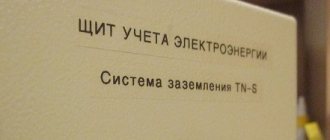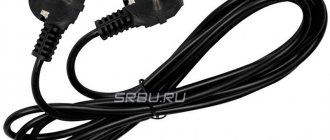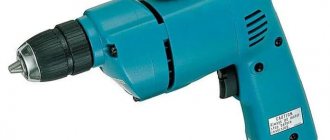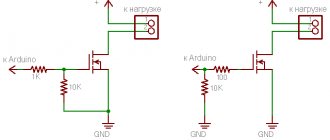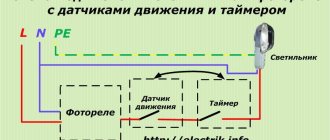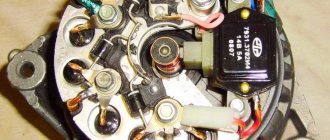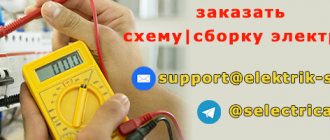The connection diagram for a single-phase electric meter presented here is universal and equally suitable for installing a one- or two-tariff electricity meter, no matter the electronic or induction (mechanical) type, regardless of the brand and manufacturer, be it Neva, Energomera, Mercury, etc.
Almost any single-phase meter has four terminals for connecting wires. Depending on the brand and functionality of a particular electric meter, the terminals may be marked differently, but the order of connecting the wires to them is the same. Therefore, for convenience and versatility, we will number them in order in the diagram, from left to right from 1 to 4.
The input electrical cable entering an apartment or house in a single-phase network consists of two (phase and neutral) or three (phase, neutral, ground) wires.
To connect the electric meter and its proper operation, we need two wires - a phase and a working zero. The article “How to determine phase, zero and grounding yourself, using improvised means” will help you determine which of your conductors is phase and which is neutral?
Universal diagram for connecting wires to a single-phase electric meter
The diagram looks like this:
In the diagram you can see a single-phase electric meter located in the center, on the left there is an input power cable (phase and zero), on the right there are wires going out to the load, roughly speaking, the electricity recorded by the meter already flows through them, which through the protective automatics goes to your sockets , lamps, etc.
The procedure for connecting wires to the terminals of a single-phase meter is as follows:
Terminal “1” – Phase wire of the input cable (usually white, brown or black wire)
Terminal “2” – Phase wire going to the load of an apartment or house (usually white, brown or black wire)
Terminal “3” – Neutral wire of the input cable (usually blue or blue-blue wire)
Terminal “4” – Neutral wire going to the load of an apartment or house (usually a blue or blue-blue wire)
A connection made according to this scheme is already sufficient for the correct operation of a single-phase meter in the home electrical network. A protective ground connection to the electric meter is not required. Additional terminals that may be on your model of a single-phase electric meter are auxiliary and serve to access service functions, maintenance, automation of energy metering, etc.
Required documents
Before starting work, you must familiarize yourself with the requirements of existing regulatory documents. If the rules are violated, the supervisory authority will take sanctions. The replacement of an electric meter in a private home is regulated by the following legal acts:
- Art. 541-544 Civil Code;
- Decree of the Government of the Russian Federation “Rules for electricity metering”.
To install or replace an electric meter, you will need the following documents:
- Statement from the home owner. It indicates: the date and place of writing; full details of the applicant; the address where the work needs to be performed; personal account number with the energy supply company; characteristics of the meter and details of the energy supply agreement.
- Photocopy of the house owner's passport;
- Power of attorney if the owner is represented by another person.
- Home energy supply agreement;
- Documents for ownership of real estate;
- A copy of the passport for the installed electric meter.
CONNECTION DIAGRAM FOR A SINGLE-PHASE METER IN THE ELECTRICAL PANEL
In a home electrical network, a single-phase electric energy meter is always installed and interacts with protective automation. All this equipment is usually located in a special box - an electricity metering and distribution panel (AMB).
And of course, there are rules according to which a single-phase electric meter is connected. If you follow them, the simplest connection diagram for a single-phase meter should look like this:
As you can see, in front of the electric meter, it is necessary to install a single-pole automatic switch, the so-called “input circuit breaker”, into which the phase wire of the input cable enters and from it the phase enters terminal “1” of the electric meter, the working zero goes directly to terminal “3”, and protective grounding (protective zero) is connected directly to the zero bus.
The load in our example is a protective circuit breaker, to which you can connect a lighting group and a differential current circuit breaker (residual current circuit breaker, differential circuit breaker) to a group of sockets. The layout of your switchboard may be different, but the principle of connecting automation after a single-phase electric meter will be similar.
This is the simplest and most commonly used connection diagram for a single-phase electric meter recommended in the PUE (electrical installation rules).
Also, I would recommend considering a more refined, improved version of the connection diagram for a single-phase electric meter, which uses a two-pole input circuit breaker.
As you can see, in this circuit, not only the phase conductor passes through the two-pole circuit breaker, as in the first case, but also the neutral conductor of the input power cable. Now, in the event of an emergency and the input circuit breaker is triggered, the neutral wire will also break, which, in some cases, may have a dangerous potential and this is not the only advantage of this connection scheme. Remember, it is important to use a two-pole circuit breaker, and not two single-pole ones that are not combined!
If you still have questions about the connection diagram for a single-phase electric meter, additions or comments to what was written, be sure to write in the comments to the article, I will try to answer everyone promptly!
To record the consumption of electrical energy, there are special devices that are well known to us as electricity meters. These devices were invented back in the 19th century and have been accompanying humanity ever since.
It is quite obvious that the production of electricity is a process accompanied by considerable costs, which must be reimbursed by those who consume this energy. Unauthorized withdrawal of electrical energy is strictly suppressed by regulatory authorities, and all violators are punished with significant fines. That is why the installation of meters, their verification and control are carried out only by energy supply organizations.
Procedure for replacing the device
Before replacing the device, many owners wonder whether it is possible to replace the electric meter themselves? It’s definitely possible, because you are its owner, but before replacing it, you should contact the energy supply organization, which will send an inspector at the appointed date to remove the seal. It is strictly forbidden to remove the seal yourself, as you may pay a hefty fine. You will also need to pay to have the seal removed and put on a new meter, but your actions will be legal. An application must also be submitted to the same organization so that your reading device is registered and you are issued a resolution.
To replace the electric meter, you can immediately pay for a certain service in your organization, then the employees will do all the work themselves. In this case, you need to adapt to the timing, and also combine all installation work, including replacing the shield, power cable, and also clarify the route for laying it. Therefore, most owners prefer to replace the device and all its components themselves, without the intervention of strangers. After the inspector has removed the seal, you can begin replacing the electrical reading device. No one can force you to change the device, but you must understand the responsibility and change the meter after the expiration date.
Types and types of electric meters
Electricity meters are usually classified according to the type of connection, the type of quantities they measure, as well as the type of design. According to the type of connection, electric meters are:
- Direct connection to the power circuit, in which the meter is connected directly to the power supply.
- Transformer connection through special measuring transformers.
Most of the electricity meters that are well known to us are direct-connection devices.
According to the type of measured values, counters are divided into:
- Single-phase electricity meters , which take into account energy consumption in single-phase networks with a voltage of 220 V and a frequency of 50 Hz.
- Three-phase electricity meters take into account the energy consumed in 380 V networks, with a frequency of 50 Hz. Moreover, all modern three-phase meters are capable of metering electricity in one, individual phase.
By type of design, meters are divided into:
- Electromechanical or induction counters, in which counting is carried out by rotating an aluminum disk in a magnetic field. The rotation speed of the disk is proportional to the power consumption, and the quantity is taken into account by counting the number of disk revolutions using a special mechanism. For example, in the common single-phase meter SO-I446, 1 kilowatt-hour of consumed energy corresponds to 1200 disk revolutions.
- Electronic meters are devices that convert an analog electrical signal taken from a measuring current transformer into electronic pulses, the repetition frequency of which is proportional to the currently consumed power. Counting the number of pulses allows you to judge the amount of electrical energy consumed. Electronic meters are gradually replacing induction meters due to their advantages.
Methods for organizing metering of consumed electricity
One of the reasons that the electricity meter is replaced is the consumer’s desire to optimize their energy costs. But since reducing power consumption in modern conditions is an almost impossible task, the only way out may be to switch to multi-tariff payments. But it should be noted that for these purposes, induction single-tariff electricity meters
are not suitable since they are only able to take into account total consumption, regardless of the time of day. One of the reasons for their popularity, which has not been lost to this day, is the low price of the device and its high reliability. But it should be noted that their use is rational only for low or medium power consumption.
Multi-tariff electricity meters are more progressive and cost-effective
which are presented on the market in two types of devices:
- two-tariff;
- three-tariff.
A two-tariff meter is capable of separately taking into account power consumption during the day and at night. The benefits of using such a device can be appreciated by those consumers who most intensively use powerful electrical appliances in the evening and at night. The loyalty of the state when developing tariffs is explained by the fact that in this case the load is redistributed across the operation of power plants and electrical networks, which allows peak loads to be avoided.
Three-phase meters, as well as two-phase ones, allow you to save by redistributing the loads from the operation of electrical appliances depending on the time of day. For such devices, when calculating, three tariffs are applied:
- day;
- night;
- peak.
If such a meter is installed, then the most expensive electricity consumption will be during peak times: from 7 to 10 o’clock and from 20 to 23 o’clock. In this case, the night tariff turns out to be the most profitable.
What advantages do electronic devices have over induction devices?
Regardless of the fact that electronic meters are more expensive than induction meters, they still have a lot of advantages that make their widespread use justified.
- Electronic meters have a high accuracy class, usually from 0.5 to 2.0, and this is maintained in difficult conditions or low or rapidly changing loads.
- Electronic meters are capable of multi-tariff metering of electrical energy, which allows consumers to save considerable money.
- In addition to the amount of energy consumed, electronic meters can also monitor its quality, which allows you to have control over the fulfillment of contractual obligations by the energy supply company.
- In addition to active power consumption, electronic meters can also measure reactive power, and can also keep track of electricity consumption in two directions.
- The data collected by the electronic meter is stored in the internal non-volatile memory of the device. This data can be accessed through a convenient digital interface.
- The use of electronic meters makes it possible to combat cases of electricity theft much more effectively. Any attempt at unauthorized access is recorded by such a counter.
- Electronic meters have a digital interface that allows you to remotely read various data from them, as well as program them for multi-tariff accounting at two or more tariffs, which apply to certain time periods.
- Electronic meters usually have smaller dimensions than induction meters, which allows them to be installed in standard electrical panels along with other modular electrical equipment .
- Manufacturers declare the service life of electronic meters to be at least 30 years, and the time intervals between their verifications range from 10 to 16 years.
One of the main disadvantages of electronic meters is their low resistance to lightning pulse discharges, from which they often fail. The share of induction meters is still quite high and they are not going to lose their positions, since their reliability has been proven by more than a century of experience in their operation. Is it true
Why do you need a multi-tariff meter and a corresponding electricity metering system?
It is known that peak electrical loads occur in the morning and evening hours. It is at this time that there is an increased load on all electrical distribution equipment, which affects the high probability of failure during these hours. Power plants are forced to burn much more fuel, which increases the amount of greenhouse gas emissions into the atmosphere.
In order to stimulate the switching on of powerful energy consumers at night, when the load is lowest, a multi-tariff policy was developed.
In Russia, the most applicable two-tariff policy is when the tariff for paying for electricity at night (from 23.00 to 7.00) is significantly lower, sometimes even 2 times lower. In some regions and other industrialized countries, up to 12 different tariffs are used. In order to take into account energy consumption with such a calculation system, single-phase two-tariff meters were developed.
Manufacturers of household appliances specially develop and produce such powerful consumers of electrical energy as washing machines and dishwashers, electric boilers with a timer start function or with a delayed start precisely so that their operation is scheduled for the night hours, when the tariff is minimal.
Obviously, multi-tariff accounting can only be carried out by an electronic meter, so everyone who wants to switch to a multi-tariff system will have to purchase just such a device.
If it is impossible to use multi-tariff metering, it is quite possible to get by with a conventional induction meter with an accuracy class of at least 2.0. Such a device will be economically justified due to its lower price and lower sensitivity, which does not allow recording power consumption by devices in standby mode (TV, stereo system, computer, etc.).
Difficult questions
Of course, the installation of “smart” devices gives rise to a number of concerns, none of which experts have been able to dispel:
- Can enumerators—with the help of specially trained people, of course—do postscripts? If so, how to track this, stop it and return excess payments?
- How many times do you have to pay fines and how much debt do you have to pay before the meter cuts off electricity to your apartment? Is it taken into account the presence in the apartment of children, bedridden patients, people on devices powered by electricity, refrigerators with vital medications in them?
- If the meter cuts off the power (instantly), when will it restore power?
So far there is silence - even the omnipresent ONF (All-Russian Popular Front) is silent. And this is true: the reform will affect the area where the human factor is fundamental - both on the part of the management company, and on the part of power engineers, and on the part of residents. And where everything depends on a person’s good will, unpredictable and sometimes criminal things can happen. In any case, only meter manufacturers will definitely benefit, with whom contracts for the purchase of equipment will be concluded: approximately 180 billion rubles.
Main characteristics that you need to pay attention to before choosing equipment
The correct choice of an electric meter must begin with a study of its characteristics, which must correspond to its operating conditions.
- Meters can be single or three-phase, and this must correspond to the type of power supply. Single-phase meters cannot count electricity in three-phase networks, and three-phase ones can in single-phase ones, but their use in such networks is not economically profitable.
- Rated electrical voltage and frequency. Usually this is for single-phase networks 220 V, and for three-phase networks 380 V. The frequency of alternating current in our electrical networks is 50 Hz. There are meters designed to account for electricity with other parameters, but they have a special purpose.
- Rated and maximum load current at which the electric meter can operate. Previously, it was normal that an electric meter could be designed for a rated current of 5 Amps, but with the widespread use of powerful household appliances, this is clearly not enough, so meters with a higher rated load current have found widespread use. In addition, the meters can operate for a long time with currents that exceed the rated current by 200%.
- The accuracy class characterizes its greatest permissible error, expressed as a percentage. For household meters, it is quite acceptable to have an accuracy class of 2.0.
- The number of tariffs indicates how many tariffs the meter can operate at.
- The ability of the meter to operate in an automated commercial electricity metering system (ASCAE) allows you to take readings remotely, as well as correctly charge the energy consumed. All modern apartment buildings are equipped with such systems. If there is no ASKUE in the house, then there are meters with an automatic internal tarifficator.
- Operating temperature range. It is now customary in private households to install meters on the street to prevent the theft of electrical energy. Therefore, the wider the temperature range, the better.
- Overall dimensions may be important when the meter is installed in a special box.
- Calibration interval and service life. For single-phase electronic meters, verification once every 16 years is sufficient, and their service life is at least 30 years.
Electric meter sealing
You cannot allow voltage into the house until a seal is placed on your meter, which confirms that no manipulations are made with the device after it has been introduced into the load. Therefore, after connection, contact your electricity supplier with a statement that you are going to start using a new meter. Please include the following points in your application:
- Information about the energy consumer (real estate owner);
- Date of installation of the metering device;
- Request to put the device into operation.
Meter sealing is paid. If the electricity supplier pays for it, then he has the right to install the seal himself or involve employees of his company in this work. If you pay for the installation of the seal, then you can also decide who will install it.
After sealing, you have the right to put a load on the chain. And this is where your work on connecting and commissioning the electricity meter ends. All that remains is to check its operation every time the next inter-verification period of time comes to an end.
Let's look directly at the connection diagram
Any single-phase electric meter is connected to the network with at least 4 wires. Of these, two wires are the input and output of the phase, and the other two are the input and output of the working neutral conductor. The connection is made using special screw terminals located on the terminal block, closed with a lid, which is sealed by Energy Supervision services.
The terminals are numbered from 1 to 4.
- Terminal No. 1 is intended for connecting the phase conductor of the network.
- Terminal No. 2 is intended for connecting a phase conductor leading to electricity consumers, that is, to an apartment or house.
- Terminal No. 3 is intended for connecting the neutral wire of the network.
- Terminal No. 4 is intended for the neutral wire leading to energy consumers.
Phase conductors are usually designated by the letter L and colors red or brown, and the zero worker is designated by the letter N and blue. In addition to them, in modern electrical wiring there is also a conductor designated PE and yellow-green. This is a protective neutral wire that is not connected to the meter or any other device. It must extend continuously from each outlet to its grounding contact.
What you need to know before installing the meter
Installation of a two-phase, three-phase electric meter in an apartment or the most common single-phase one is carried out according to paragraphs. 1.5.27–1.5.38 PUE.
Requirements for the counter:
- availability of technical passport, certificate;
- verification deadlines not missed;
- entry into the State Register. The number is stamped on the case and written in the passport;
- seals with a stamp: confirming verification. The product goes on sale already with such a seal;
- from energy sales. Installed when connected to the mains;
The connection of the electric meter and the circuits for different types are similar, the nuances are minor, for example, on three-phase devices there are terminals for 3 phases and a working zero.
Innovations
The provision of electricity to facilities, as well as the installation of metering devices, is carried out in accordance with the rules of the Electrical Regulations. As it was before PP N 554: the user selected and bought an electric meter, found out from the local energy sales office whether they work with such a model (recommended list on the institution’s website). Next, install and connect a two-, three-, single-phase meter with your own hands or using the services of specialists and no later than 1 month. submitted documents for registration of an organization that supplies energy.
Now all planned procedures, including purchase, replacement, installation, control of inspection deadlines, are carried out by energy sales. In addition, I will gradually replace conventional products with “smart” devices that automatically send indicators and data about their condition remotely.
The cost of installation, the product itself and manipulations according to PP N 554 for the user is conditionally zero. That is, previously the law stipulated that the purchase and maintenance of the meter were paid for by its owners, now it is the service provider, but the price of the service was included in the tariff. In fact, the fee is now included in the monthly subscription fees. A positive point: the citizen is not obliged to monitor the condition of the device, the frequency of verifications, checks, he must only provide access.
But additional procedures, not included in the minimum list, carried out unscheduled, may be paid, for example, replacing a device before the verification and operation period has expired.
Is it possible to change electricity meters yourself?
According to paragraph “c” of PP No. 554 and according to paragraph 139 R.X of the Basic Provisions ... dated May 4, 2012 No. 442 “On the functioning of retail markets e-mail. energy..." dismantling of electricity meters is allowed only with the approval of the electricity supplier; it is prohibited to do this at your own discretion.
Self-installation is possible with the permission (written) of the energy supply company at the request of the user. After the adoption of PP N 554, such a procedure became less relevant, but it is appropriate if a citizen does not want to wait for a planned replacement or wants to install a multi-tariff or, in his opinion, better model. Theoretically, the work will require an electrical safety group of at least 3, but this is a recommended rule, and, of course, it is often not followed. But you need to notify the supplier about the replacement and find out if he seals the product.
After installation, it is not advisable to immediately connect to the network - incorrect connection will result in a fine, and the amount of sanctions in this area is extremely large. You must submit an application to the supplier to register the device and make the connection when an employee of the institution checks the installed device, seals it and registers it.
Let's understand the intricacies of installation
Preparatory work before installation
First, the location where the electric meter will be installed is determined. In apartment buildings, there are special power cabinets in the entrances, where there are regular places for meters, and owners of country houses or summer cottages should take care of purchasing a special box specifically designed for installing electricity meters. Such boxes have transparent doors or windows that make it easy to take readings, as well as places for installing modular electrical equipment.
Basic technical requirements for installation
All work must be carried out with the network de-energized; the shutdown is done at the main switchboard, ASU. The presence of voltage is checked with a conventional multimeter, voltmeter, pointers (indicator screwdrivers).
Before installing an electric meter, you should at least be familiar with the wiring standards in general. The cross-section of the conductors entering the apartment according to clause 7.1.34 of the PUE must be at least 2.5 mm², the material is copper. The standard is 6 mm². But this is not a strictly fixed characteristic - its value depends on the total power of electrical appliances in the house.
Results
- Modern electric meters are complex devices, the installation and maintenance of which should only be carried out by qualified and authorized specialists.
- If multi-tariff metering is possible, it is better to use this service, which saves considerable money, but then you will have to purchase meters with the possibility of such metering.
- Unauthorized access to the electricity meter terminals is prohibited; all operations must be performed only by employees of electricity supply organizations.
Cost of installation or replacement of an electric meter
It should be noted right away that the price of installing an electric meter depends on many factors and is not fixed. It is primarily influenced by: the complexity of the work to be done, its volume, as well as the type of device being mounted.
The least expensive option is to install a single-phase induction (mechanical) device. This service, provided by many organizations, costs on average from 1,500 to 2,000 rubles. The cost of installing meters will be higher
with a multi-tariff method of metering electricity consumption. For example, to install a two- or three-tariff device you will have to spend up to 2,500 rubles. The installation of three-phase devices turns out to be the most expensive - their installation costs, on average, from 2,500 to 3,500 rubles.
But when comparing the cost of installing different types of electricity meters, it should be taken into account that the price of electronic products is sometimes several times higher than the cost of mechanical devices. Also, three-phase products are always more expensive than single-phase ones, but in this case the consumer has no choice, since the need to install this particular type of device is determined by the load and the characteristics of the home’s electrical network.
Source
Typical single-phase network input circuit
The vast majority of apartments, garden plots and small household facilities such as garages are connected to a single-phase network. The method of connecting the measuring device (electricity meter) and the protective circuit elements (RCDs, circuit breakers and differential circuit breakers) is the same.
Depending on the operating conditions and powered devices, the connection diagram of a single-phase electric meter may undergo the following changes:
- No ground input.
- Lack of an individual input machine in front of the counter. It can be common to several circuits equipped with metering devices, or an ordinary manual switch (switch) can be installed instead.
- No branching into multiple circuits.
- Lack of RCDs and automatic circuit breakers protecting the line after the meter.
If there are no automatic circuit breakers or RCDs between the meter and consumers, then in the event of a short circuit or significant overload, the meter will break down. Therefore, protection is needed immediately after the metering device, especially since the simplest circuit breakers are cheap.
Who will pay and how much?
Installation of meters is free by law. But somewhere the management company, taking advantage of the residents’ legal illiteracy, will issue an invoice for the device and installation, dividing the payment into 12 tranches and including it in the total electricity bill - seemingly unnoticeably. By the way, the device costs from 3 to 12 thousand rubles. We must not forget about scammers: they will definitely install a meter for money and get their hands on it. Considering that approximately 22 million devices will need to be installed throughout the country, the black market will not miss out. Be carefull!
And don’t be too happy: in addition to installing meters, there is also the process of servicing them. This will definitely (and legally) be included in the receipt, raising the tariff by a few kopecks. Let me remind you that maintenance of metering devices in proper condition and timely verification is the responsibility of the consumer.
Division of responsibility for electrical appliances
The electrical distribution throughout the facility is protected by separate switches that regulate the maximum permissible current for sections of the circuit. Payment for their purchase and connection is made by the owner of the premises.
The electricity meter and the input machine can be physically located not only in the consumer’s area of responsibility. If these devices are located in a privatized apartment, in a garage, in a utility room or within the boundaries of a cottage or summer cottage, then their installation, maintenance and replacement are carried out by the owner of the property.
His responsibilities also include providing energy service employees and the management company with access to the meter for reading, sealing or checking. Also, specialists have the right to install magnetic seals. If the user of the premises refuses access to the premises without a valid reason, the electricity supplier may transfer him to a general tariff.
If the devices are located in municipal (non-privatized) property, common territory (entrances) or outside a private area, then all costs are borne either by the supplying organization or they are shared. In this case, the organization of work and payment is made by the management company, HOA, GSK or gardening partnership.
We talked in more detail about the legal intricacies of replacing and installing electricity meters in this material.
How to register a new counter
Commissioning of the device is mandatory, otherwise the readings will not be taken into account.
Registration procedure in 2021:
- An application is submitted to the utility service provider (MC, HOA, Energosbyt). The document contains all the IPU information, personal data and address. A copy of the product passport is attached.
- At the appointed time, an employee will come and check the functionality of the mechanism and the correct installation. Adjustments are made if necessary.
- If there are no comments, then sealing is carried out and a corresponding report is drawn up.
- The supporting document is submitted independently or through a specialist to the service company.
After completing all procedures, the electric meter is considered registered and put into operation.
Connecting the meter and machines
If the place for installation of metering and protection devices is located in the area of responsibility of the owner of the premises, then it is necessary to install them in accordance with the standard connection diagram for the electricity meter and automatic machines.
Installation of distribution board
For ease of installation and protection of electrical appliances, it is best to use distribution boards specially manufactured for these purposes.
Typically, only the following type of equipment is installed in such a shield:
- introductory machine;
- electricity meter;
- circuit breakers, fuses and other control and protection devices;
- residual current devices;
- terminals, buses and other switching elements;
- elements of non-power networks, for example, for cable television;
- uninterruptible DC power supply units with remote batteries;
- control units for the “smart home” system.
A metal or plastic box protects the devices placed in it from physical impact, moisture and dust. Apartment panels located in the consumer's area of responsibility are not sealed so that the owner of the premises has access to circuit breakers. This procedure is carried out only for the counter.
The panels are equipped with a special profile made of plastic or galvanized metal - a DIN rail. All modular equipment, including meters, is mounted on them. This allows for compact and reliable placement of block equipment.
There are two types of electrical panels:
- Mounted. Their back wall is collapsible. It is removed and attached to the wall using self-tapping screws and dowels, and then the housing is put on. When choosing this option, you need to decide in advance on the location of the plant in the electrical wiring panel.
- Hidden installation. In this case, it is necessary to hollow out a niche under the shield.
When choosing a model, you must first make sure that there is enough space for all electrical system control components. It is better to take a shield with some reserve volume, since in the future it is possible to attach new automation.
If you need to install a switchboard outdoors, then there are special models for this that will protect the equipment from rain, snow, strong winds with dust and other natural phenomena.
We also recommend reading our other article, where we discussed in detail how to connect an electrical panel. For more details, follow the link.
The need for an introductory machine
The need to install an introductory machine and its rating can be specified in the contract for the provision of services for the supply of electricity. If there are no such requirements, then it is still better to use the machine.
The fact is that for installation and work with metering and control devices for electricity supply, it is necessary to de-energize the network. If the introductory machine is located on the consumer’s premises, then you can turn it off yourself.
Otherwise, turning off the electricity supply can only be done with the permission of the electricity supplier, and it will be necessary to call a specialist, since access to the general distribution boards by outsiders is prohibited.
This creates the following problems:
- it is necessary to agree on the shutdown time;
- if several consumers are connected to one switch, you will have to notify them of a temporary power outage;
- Calling a specialist in a non-emergency situation will cost money.
The time for carrying out all work when the electricity is turned off will be limited. Therefore, you need to immediately prepare the place, tools and perform preliminary steps that do not require a lack of power.
Therefore, before connecting the automation and single-phase electricity meter, it is better to install the input circuit breaker once than to negotiate this with electricians every time you need to work in your own electrical panel.
Modern electricity meters
Currently, electrified facilities have two types of meters: outdated electromechanical ones or new electronic ones. There are two main indicators for any type of electric meter.
The accuracy class (CT) determines the maximum permissible error in percentage when measuring electricity. At the moment, there are classes of household meters (from lower to higher): “2.5”, “2.0”, “1.0”, “0.5” and “0.2”. According to clause 138 of the Government of the Russian Federation No. 442 of 05/04/2012, for individuals this parameter must be 2.0 or higher.
Therefore, when purchasing a device, there is no need to purchase models with a higher class, for example “0.5”. They are less popular and more expensive, so managers of trading companies often try to sell such devices to buyers unfamiliar with the topic.
The second important indicator is the maximum current that the device can pass through. For domestic and residential premises, this figure for a single-phase device cannot be more than 60 A.
There are also multi-tariff meters that can be programmed to calculate electricity consumption at different daily periods.
Most metering devices are installed on a DIN rail in a distribution board. In this case, the model of the switchboard and meter must be selected in such a way that readings can be taken through the window without opening the door - this is very convenient.
A single-phase meter has 4 power terminals for connecting wires. Always, if you look at the device, then from left to right they go in the following order:
- Coming phase.
- Outgoing phase.
- Incoming neutral.
- Outgoing neutral.
Before starting installation work, it is necessary to de-energize the wires: turn off the incoming circuit breaker or switch, and also be sure to check the absence of voltage with a multimeter or an indicator screwdriver. And not only in phase, but also in neutral.
Both the meter and all automation are mounted on a DIN rail using the latches present on them.
Next, you need to strip the wires that come from the input circuit breaker using an insulation stripper or a utility knife. The length of the segments should be such that they do not dangle, but are not tight either. The cleaned ends are inserted into the clamps and tightened with a screwdriver, and both screws must be properly tightened.
Circuit breakers and RCDs
With your own hands, you can connect not only an electricity meter, but also automatic machines that will protect the line and the meter from overload and short circuit.
All devices are also mounted on a DIN rail. The machines are connected only to the phase, and the RCD is also connected to the neutral, which is connected to the bus. It is advisable to leave a small space between the machines, since during operation they heat up, and air access from the sides helps with cooling.
The ground wire goes separately to its own bus. It does not go into the meter, as well as into machines and RCDs.
Installation features and work progress
When installing electricity metering devices, great attention should be paid to safety regulations. All work must be performed by specialists licensed to work in electrical installations.
Installation location
The installation location of the device is chosen so that there is access to regulatory authorities. In an apartment building, this place is the landing. And in a private house they select a place to which there is easy access.
The wires are installed in such a way that visual inspection can be carried out. Twisting and other connections up to the meter are not permitted.
Installation height
The operating rules for electrical installations require that the electricity meter be installed at a height of 0.8-1.7 m. In practice, specialists place the electricity meter in such a way that the data can be easily checked by an inspector. This installation height is 1.5 m from the ground. Which does not contradict the PUE.
Connecting protective electrical equipment
Protective electrical equipment is selected according to the connection diagram. This depends on the supply network - single-phase or three-phase.
The machines are mounted (if possible) on each load line. For example, lighting lines and sockets are protected by their own circuit breakers. The line supplying household appliances is protected by RCDs or differential protection devices.
All devices are connected to a common switch, which protects the electric meter from overload and short circuit currents. The general circuit breaker is selected based on the total load currents, and the devices protecting a separate line are selected taking into account the connected load.
On the input side, a disconnecting device is installed in front of the metering device. Such devices are automatic or batch switches.
Electric meter connection
If the panel is correctly assembled, connecting the meter should not cause any difficulties for specialists. The wires should be connected according to the existing diagram. It shows which conductors are connected to the contacts. It is available in each meter on the back of the cover that covers the meter contacts.
The correct connection must be checked by an electrician from the electrical network. He connects the electric meter and supplies electricity to the apartment.
Settings
Single-tariff metering devices do not require additional configuration. Once connected they are ready to go. The situation is more complicated with multi-tariff devices. After installation, they need to be configured.
However, configuration is only necessary if the data will be transmitted automatically to Energosbyt. Such services are not provided in every locality, and setting up a transmission port requires special equipment and knowledge. This is usually performed by Energosbyt specialists.
If you do not plan to transmit data automatically, then you do not need to configure a multi-tariff meter. The initial setup has already been done at the manufacturer's factory. The owner only needs to take monthly meter readings.
To do this, use the “enter” button to switch the device readings by tariff zones. This data is transmitted by the owner to Energosbyt. Where they make calculations and issue invoices for payment, according to the day and night tariffs.
Conclusions and useful video on the topic
Equipping the panel with a meter, machines, socket and buses:
Assembling an apartment panel with your own hands:
Replacing or installing a single-phase electric meter yourself is quite simple. But when working with electricity, you must follow safety rules. Including not changing the sequence of devices in the connection diagram.
If you have the necessary knowledge and skills for connecting a single-phase electric meter, please share it with other visitors to our site. Tell us about the connection nuances that you know. Leave your comments and ask questions in the block below the article.
Approval procedure
Before calling a service company, check to see if the electrical wiring in your home is in good condition. If there are problems, it is better to fix them yourself. If, during the replacement of an energy meter, gross violations are discovered, a fine cannot be avoided.
Having collected all the necessary documents, you need to contact the management company. In the contract, look at who took the meter on balance; it could be the management company or the owner of the house.
The replacement may be planned or unplanned, but in any case it is registered with the energy company, so it is necessary to follow the procedure.
Electric meter in the panel
The application for the need to replace the electric meter is registered with the company; you will have to wait several days until it is entered into the state register. After this, you need to get a certificate from the energy company, according to which you can buy a new meter, or you can buy it from a service company.

